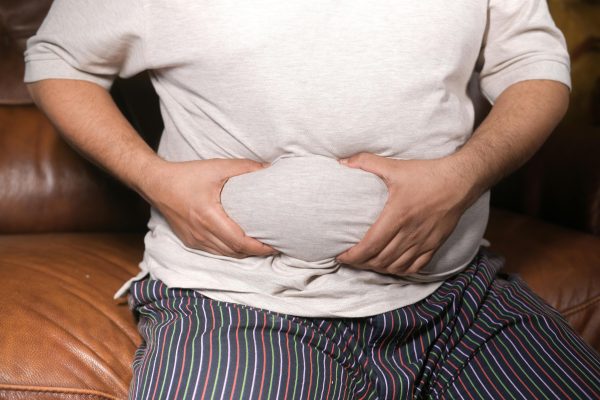- How does an erection work?
- Stages of getting erect: four phases
- The Cycle of Erection Response
- Desire
- Arousal
- Ejaculation and Orgasm
- Refractory period
- Stay Hard
- Get Pumped
- Showers vs. Growers
- The average erect penis size: fiction vs. stats
- What makes the penis so tough?
- From erection to ejaculation: how long does it take
- Different Types of Erections
- How long does the average male last in bed?
- How long should a man last in bed?
How does an erection work?
Erection is defined as “the state of the penis when the erectile tissue becomes filled or swollen with blood and causes the penis to become rigid and elevate.”
Wood, boner, hard-on, —Whatever you want to call it, an erection is a much more complex and surprising event than the most common nicknames ascribe to it.
A more appropriate nickname would be The Rocket.
Although getting stiff isn’t rocket science, many complex systems and stages of getting erect must work together for a successful launch.
All the elements of a rocket—the super-strong materials, the hydraulic lines, the fuel, the circuitry, and even mission control—exist, in a way, inside your penis.#
Erection is a complex process that involves the endocrine, muscular, vascular, and neurological systems.
Don’t forget that these systems are affected by psychological and emotional factors. Science still does not know all the intricate dynamics of how erections come and go.
We know even less about the all-important brain-penis connection.
However, we understand many of the essential steps of getting an erection. The penis gets hard in a series of distinct stages.
Stages of getting erect: four phases
Erection is a complex physiological process that is essential for sexual activity. It involves the coordination of various bodily functions, including the nervous system, blood flow, and hormones. The process of getting an erection can be broken down into four main stages:
- Sexual stimulation: The first stage of getting an erection is sexual stimulation. This can be triggered by visual, auditory, or tactile stimuli, such as seeing an attractive person, hearing a suggestive sound, or feeling an intimate touch. The brain receives these stimuli and sends signals to the nervous system, which triggers the release of certain chemicals called neurotransmitters.
- Vasodilation: The second stage of getting an erection is vasodilation. This is the process by which blood vessels in the penis dilate or expand, allowing more blood to flow into the cavernous bodies of the penis. This increased blood flow is caused by the release of nitric oxide, a chemical messenger that triggers the relaxation of smooth muscle in the blood vessels.
- Tumescence: The third stage of getting an erection is tumescence. This is the process by which the cavernous bodies of the penis fill with blood and become engorged. As the blood fills the cavernous bodies, the penis becomes harder and stiffer, resulting in an erection.
- Rigidity: The fourth and final stage of getting an erection is rigidity. This is the stage where the penis reaches its maximum hardness and stiffness. At this point, the erectile tissue is fully engorged with blood and the penis is ready for sexual activity.
It’s important to note that the process of getting an erection can be affected by various factors such as age, health, and lifestyle. Certain medical conditions and medications can also interfere with the ability to get an erection, as well as psychological factors such as stress and anxiety.
In conclusion, the process of getting an erection is a complex physiological process that involves the coordination of various bodily functions. It is a four-stage process that starts with sexual stimulation and ends with rigidity and can be affected by various factors such as age, health, and lifestyle.
The Cycle of Erection Response
Remember, normal erection response follows a cycle:
— Excitement — DESIRE
— Plateau — AROUSAL
— Resolution — EJACULATION & ORGASM
— Refractory period
Desire
The factors that excite any given man at any particular time are enormously varied and idiosyncratic.
There is nothing more characteristic of sexual response than the fact that it is not the same in any two individuals.
– Alfred Kinsey –
Touches create desire. It perks up when other parts of the body are touched erotically: the thigh, the buttocks, the abdomen, the neck, the lips, and other erogenous zones. Your penis can also get aroused when you touch the right part of someone else’s body. As you can see, the penis has an extensive “sense” of touch that is necessary for arousal.
Many researchers believe that a chemical substance known as a pheromone stimulates the sexual response.
Pheromones are secreted from a woman’s skin and vagina. Such pheromones can stimulate a sexual response in males simply through the olfactory sense, the sense of smell. Pheromones are also known to work in the opposite direction. Women can be affected just as much as men by these invisible signals. This natural aphrodisiac is nature’s way of ensuring that male and female animals reproduce.
As for the other senses, consider the impact of certain sounds: romantic melodies, erotic rhythms, a gentle surf, a breeze rustling through the trees outside the bedroom window. Envision also sweet, erotic words whispered in your ear: “I want you so badly,” “You’re so sexy,” “Do it to me.” The penis responds as if it had ears of its own
Your penis responds to what you see. More importantly, it responds to the prospect of what you might see.
Desire involves more than just the senses. The mind and emotions are also crucial players. The same stimuli that may work like magic on one occasion may elicit indifference on another. It all depends on your mood and the psychological undercurrents at that moment.
The strokes, scents, and sights of a person you love, or one you have been lusting after, will produce vastly different effects than the strokes, scents, and sights of someone you cannot stand. Desire can occur without any help from the senses at all. Imagination is often sufficient enough.
And is often required.
Arousal
The first reaction occurs when the nerves are stimulated, causing microscopic blood vessels in the corpora to dilate. This is arousal.
Whether the stimulation begins with something a man sees, hears, smells, feels, or imagines, it is the brain that determines the level of arousal. The complex neural connections between the brain and the penis are difficult to define and quantify. The link is so intimate, immediate, and responsive, it is as if the penis has eyes, ears, and a nose. Certainly, it seems that way to an aroused man.
The penis reacts most dramatically to touch. It is an exquisitely sensitive organ, particularly the glans and the shaft. Exactly what kind of touch will arouse any particular penis is entirely a matter of individual preference, conditioning, and circumstances. Some men like a soft, gentle touch, while others prefer a vigorous, perhaps even rough stroke. Some men respond to the friction of a dry touch, while others favor a moist one. Some find the slow, rhythmic movement a turn-on, while others go wild over rapid, irregular motion. Some like all of these touches to different degrees at different times.
Penis responds to oral contact very well. It is not just the texture of the lips and tongue on the penis, it is not just the psychological charge of having your partner perform such an intimate and generous act, but it is the actual physical effect of sucking.
Sucking creates a vacuum. A vacuum creates negative pressure within the corpora, drawing blood into the organ. And that inflow of blood creates an erection.
Ejaculation and Orgasm
Most of the time, men have orgasms when they ejaculate. This is referred to colloquially as “coming.”
Nature designed the mechanism of erection for procreation. The reflex of ejaculation follows erection. Ejaculation is not to be confused with orgasm, even though the two usually, but not always, go together.
Orgasm refers to the intense feeling of pleasure and release felt at the climax of sexual excitement. Orgasm is mainly neurological in nature. It is an electrochemical event centered in areas of the brain that govern pleasure.
Most men have had the disconcerting experience of ejaculating without the pleasurable sensation of orgasm. This may have happened when, as adolescents, they were so overwhelmed by excitement and anxiety that they “came” in their pants.
Conversely, some men have experienced the reverse: orgasm without ejaculation. Some esoteric Eastern sex practices can accomplish this.
Ejaculation is the discharge of semen through the penis. This occurs through a reflex action involving a number of body parts. Let’s begin with an explanation of the production of semen, or ejaculate.
The ejaculate is powerfully propelled from the back of the urethra through the penis and out the tip. It squirts out in several jellylike clumps, which quickly liquefy into an opaque fluid, allowing the sperm to swim to the ovary.
Exactly how much is ejaculated varies with factors such as age. The older you get, the less semen is produced. Ejaculation is also influenced by the length of time since the previous ejaculation; the longer it has been since the last ejaculation, the greater the amount of semen.
The volume ejaculated decreases with age because the body simply produces less. The forcefulness of ejaculation also decreases with age due to a natural decline in muscular strength and changes in the vascular system. A young man might project 5cc of ejaculate halfway across the room while an older man might just dribble a few drops. The mechanism is exactly the same.
When ejaculation occurs, or when arousal is interrupted for some reason (the phone rings, you get nervous, or an unexpected cramp in your leg occurs) the result is detumescence. Detumescence is the release of blood from the corpora. During this process, the smooth muscles around the sinusoids and small arteries contract, and the roadblocks in the venous system open up, allowing blood to flow back out. When detumescence occurs, the penis quickly and efficiently becomes flaccid.
Refractory period
The refractory period is a very important part of the erection cycle.
As soon as ejaculation is completed, the process is reversed. Heartbeat, blood pressure, and respiratory rate gradually slow down to resting levels.
You feel sated and relaxed, and perhaps sleepy.
The scrotum, which reflexively contracts during sexual arousal, and the testes, which rise up within the scrotal sac, relax into their usual positions.
The penis, as the blood drains out, reverts to its flaccid state. It is as if the penis, having worked so hard, wants to retreat into solitude and not be seen.
The head of the penis becomes extremely sensitive. It does not want to be touched. It does not want to be sucked. It might even burn or hurt if it makes contact with anything.
During the refractory period, you cannot ejaculate again.
It is as if, after ejaculation, the penis dons a neon sign that reads “Leave me alone!” This is a time of rest. This is a time when the male body restores its energy before it can once again become aroused. This is a refractory period. No amount of stimulation will produce an erection or ejaculation.
The two main variables that determine the length of the refractory period are age and the length of time since the previous ejaculation.
Exactly how long it takes for your sexual function to be restored varies considerably from one man to another. Any man will notice distinct variations in his refractory period depending on his partner, the circumstances of the sexual encounter, and other physical factors such as fatigue and general health.
The two main variables that determine the length of the refractory period are age and the length of time since the previous ejaculation.
Generally speaking, men need more time to rest the older they are. This means a longer refractory period.

Stay Hard
Let’s talk about the super-strong materials.
Despite the colloquial term for an erection—the “boner”—there are no bones in the penis. Beneath the skin, which is extremely sensitive (especially the part we call the head or glans, so named because the ancients thought it looked like an acorn), the penis is composed of three cylinders made up of spongy tissue. The penis is not a muscle also.
How the penis works
The penis is fundamentally composed of three cylinders.
Two of these cylinders are situated side by side.
They are the ones that make up the shaft of the penis during an erection and they get filled up with blood.
The third cylinder is situated right below the first two, and it’s where the urethra (pee channel) runs and gives rise to the head of the penis.
These shaft cylinders, also called corpora cavernosum (Latin for “bodies filled with hollow spaces”) are surrounded by one of the strongest yet most flexible tissues in the body named the tunica (Latin for “long, sleeveless shirt like a tunic”—very fashionable in ancient Rome) albuginea (as in albino, or “white”).
Get Pumped
This special tissue has the amazing property of allowing your penis to expand like a balloon but also become hard like steel.
These cylinders are filled with blood, not air, and as they fell, they stretch out and expand anywhere from two to five times their original volume.
Once they expand all they can, they get more and more rigid, like tire pressure.
Showers vs. Growers
Your penis is anchored deep inside you, so what you see dangling from the outside is just part of it.
Here’s a remarkable fact:
Your penis is twice as long as you thought it was, and maybe actually as long as you said it was!
Those penises on the lower end of the expansion spectrum are the “Showers,”
and those on the higher end of the spectrum are the “Growers.”
Showers look bigger in the locker room.
But Growers are undergoing dramatic changes when they start to act..
The veins that drain the blood out of the penis travel through the walls of the shaft cylinders, but as the cylinders expand under pressure, they pinch the veins shut, trapping the blood in the erect penis.
The pressure inside the shaft rises higher than the blood pressure in the rest of the body, and additional blood can no longer be pumped into the penis.
But it gets even more intense. At the base of all three of the cylinders are special muscles (ischiocavernosus muscles) that surround and squeeze them.
As these muscles squeeze, that pressure gets even higher, giving you the pulsating love pump you know and love.
The average erect penis size: fiction vs. stats
Men believe that the average length of an erect penis is greater than 6 inches (15.24 cm) closer to 7-8 inches
The average erect penis size is 5-6 inches.
The study of Erect Penile Length and Circumference Dimensions of 1,661 Sexually Active Men in the United States showed that the mean erect penile length is 14.15 cm closer to 5.5 inch.
It is impossible to know for certain, and an act of faith is required to accept it.
Growing up I always believed the average was 6-7 inches and accepting this new assessment was really quite difficult because nobody I knew had ever said they have a dick less than 6 inches. To be fair, I’d never told anybody my own size. Whenever the question of size came up I just kinda kept quiet. I realize now that guys who were less, just like me, didn’t tend to mention it. It was invariably the bigger guys that were happy to openly discuss such stuff. So I developed a pretty skewed view.
Ant Smith “The Small Penis Bible”
Early research (the Kinsey institute) also reported the average at around 6 inches so it all seemed to stack up.
Q. What is the range of erect penis length for most men?
A. 5–6.5 inches*Q. What is the average circumference?
A. 4–5 inches*
But we well know the early research was flawed. We know most smaller guys don’t brag. We know larger guys may well brag, or go on display in the locker room or in porn. We know guys will ambitiously round up when measuring. We know everything we see or hear on the subject of penis size inflates reality.
So accepting that the average is a little over 5 inches may well take a leap of faith, but it is a leap worth taking. Let me be absolutely clear:
The average cock size is 5.1 – 5.5 inches. According to this study.
Believe it 68% of men, according to statistics, will be in the range ~4.5 – 6.0 inches (assuming a standard deviation of 0.8 inches) and therefore 16% of men will be under 4.5 inches. Does this mean anything under 4.5 inches is small? Well, that’s a judgment (not a fact) you might well make. Perhaps you’re comfortable with classifying 1 in 6 men as having a small dick. Perhaps that seems reasonable. Most guys seeking surgeries and penis enlargement magic have normal-sized penises.
True information about penis size might be effective in alleviating concerns for the majority of men who worry about having a small penis.
What makes the penis so tough?
The special material lining the cylinders, the tunica albuginea, has a structure that is unique in all the body.
It is made of collagen fibers, the same tissue that gives our skin, blood vessels, and tendons their strength and integrity.
But unlike in those structures, the collagen is specially arranged in wavy bundles that circle the cylinders.
That circular layer is surrounded by another layer or two of long, straight collagen running lengthwise along with the cylinders.
Your blood vessels are the hydraulic lines of your pocket rocket.
The arteries that pump blood into the penis branch off from larger arteries that go to your pelvis and your legs.
Those “penis” arteries are smaller arteries in the body at barely 1 millimeter in diameter at best.
Blood flows to your penis through these arteries.
Compare the arteries that provide blood to the heart are about five times wider in diameter.
So it’s obvious why, when we get older and our blood vessels get narrower, the ability to have an erection is usually the first thing to go.
But for a healthy penis, those narrow arteries work just fine.
When you have an erection, the blood flow increases.
The final result is the elasticity plus strength that leads to lengthening and widening.
You feel rigidity with remarkable toughness.
The fully pumped penis doesn’t bend or buckle.
He gets hard.
You get an erection.
Let It Flow
The reason that blood flow can change is that the arteries have a muscular lining that can squeeze closed to slow down the blood flow, like when you turn off a faucet. Or the lining can relax, allowing the blood vessel to stretch open wider, like when you open up a faucet.
The narrowing and widening of this muscle layer are controlled by the particular nerves that are not under your conscious control. They are called sympathetic nerves, and they are constantly at work, like traffic cops, directing the blood flow throughout your body.
Sympathetic nerves run all along the wall of every artery in your body, not just those in the penis. These nerves release adrenaline into the muscle wall of the arteries, which makes them open up or close down more, depending on which part of the body they are in.
Erection is a complex process involving the central nervous system; peripheral nervous systems; hormones; smooth muscles; and vascular functions” -Medline’s definition
From erection to ejaculation: how long does it take
During a sexual act, ejaculation is initially under some control until you reach that level of excitation we call the point of “ejaculatory inevitability.”
Ejaculatory inevitability is the point when ejaculation becomes completely reflexive and out of our control.
There are a lot of problematic premature ejaculations in guys who are sexually inexperienced or in those men who have a poor understanding of the sexual response cycle, infrequent sex, or problematic relationships.

Different Types of Erections
There are 3 types of erections:
- Reflexive erection
- Nocturnal erections
- Psychogenic erection
Reflexive erections occur instantly, even if you can not think about sex.
Nocturnal erections including morning wood can last up to 25-35 minutes.
Psychogenic erections occur when you get audiovisual stimuli or remember some intimate memory or fantasy. i
How long does the average male last in bed?
There are a lot of problematic premature ejaculations in guys who are sexually inexperienced or in those men who have a poor understanding of the sexual response cycle, infrequent sex, or problematic relationships.
To put this whole picture into numbers, the average length of intercourse for men with premature ejaculation is under two minutes.
For men with normal ejaculatory responses, it is somewhere between seven and a half and nine minutes.
Don’t we all wish it were longer?
How long should a man last in bed?
The time duration of an erection can occur between a few minutes to more than half an hour.
This is estimated from the time when the maximum hardness is attained.
The duration of time of erections depends on many factors
- Your Mental and Psychological State
- Your Physical Health status
- Your Age
- Sexual activity frequency
- Type: Masturbation or Intercourse
- Using pills, meds
- With alcohol or drugs
An efficient erection is a marker of good health
If you are worried that you may suffer from possible premature ejaculation, ask yourself these questions:
— Are you dissatisfied with your sex life because of your lack of staying power?
— During the majority of times you have sex, do you ejaculate before you wish?
If you answered YES to these questions, or if you don’t satisfy with the average “normal ” time of erection, there are solutions available.
Through science, we are becoming more equipped and better informed to deal with this ever-present problem.
We get the expertise to make available a wide variety of topical and oral “off-label” agents that can be used to prolong your staying power.

SCIENTISTS DISCOVERED A SIMPLE AND EFFECTIVE WAY TO GET RID OF ERECTILE DYSFUNCTION
Unique complex for potency and prostatitis
Bluestone includes capsules for daytime use and drops for night use. The fluid form is necessary for the maximum amount of natural ingredients to be absorbed overnight.
-
Neuroanatomy of the penile portion of the human dorsal nerve of the penis
- Menstuff.org, “Do You Ever Fantasize about Someone Else During Sex?,” http://www.menstuff.org/columns/numbers/archive.html (accessed February 4, 2011).
- Department of Health and Human Services, “Male Circumcision and Risk for HIV Transmission and Other Health Conditions: Implications for the United States,” Centers for Disease Control and Prevention, http://www.cdc.gov/hiv/resources/factsheets/circumcision.htm (accessed February 4, 2011).
-
Penis Power: The Ultimate Guide to Male Sexual Health by Dr. Dudley Seth Danoff MD, 2011
-
G. J. Christ and T. Lue, “Physiology and Biochemistry of Erections,” Endocrine 23, nos. 2 and 3 (2004): 93–100.
- M. Bitsch, B. Kromann-Andersen, J. Schou, and E. Sjontoft, “The Elasticity and the Tensile Strength of Tunica Albuginea of the Corpora Cavernosa,” Journal of Urology 143, no. 3 (1990): 642–5.
- K. E. Andersson and G. Wagner, “Physiology of Penile Erection,” Physiological Reviews 75, no. 1 (1995): 191–236.
- I. Saenz de Tejada et al., “Physiology of Erectile Function,” The Journal of Sexual Medicine 1, no. 3 (2004): 254–65. G.
- J. Christ and T. Lue, “Physiology and Biochemistry of Erections,” Endocrine 23, nos. 2 and 3 (2004): 93–100. L. J. Ignarro et al., “Nitric Oxide and Cyclic GMP Formation upon Electrical Field Stimulation Cause Relaxation of Corpus Cavernosum Smooth Muscle,” Biochemical and Biophysical Research Communications 170, no. 2 (1990): 843–50.
- W. D. Steers, “Pathways and Central Sites Involved in Penile Erection: Neuroanatomy and Clinical Implications,” Neuroscience & Biobehavioral Reviews 24, no. 5 (2000): 507–16.
- F. Giuliano and O. Rampin, “Neural Control of Erection,” Physiology and Behavior 83, no. 2 (2004): 189–201.
How long can the average man stay erect [and how to stay longer]







A motivating discussion is definitely worth comment. I do believe that you ought to publish more about this subject, it may not be a taboo subject but usually people dont speak about these subjects. To the next! Kind regards!!